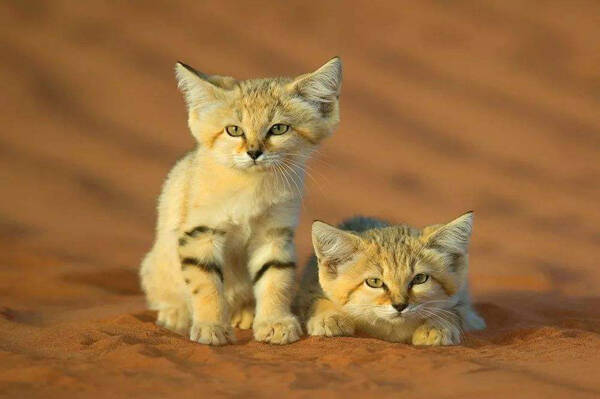Felis margarita
IUCN
LCBasic Information
Scientific classification
Vital signs
- length:45-57cm
- Weight:1.5-3.5kg
- lifetime:About 13 years
Feature
Short legs, large head, large ears, long tail
Distribution and Habitat
Distributed in Algeria, Chad, Egypt, Iran, Iraq, Jordan, Kazakhstan, Kuwait, Mali, Mauritania, Niger, Oman, Saudi Arabia, Sudan, Syria, Turkmenistan, United Arab Emirates, Uzbekistan and Western Sahara.
Possibly extinct: Israel, Pakistan and Yemen.
Uncertain: Morocco and Qatar.
The distribution area of the sand cat is divided into five parts: the southern part of the Arabian Peninsula, the arid Sahara Desert in North Africa, the area around the Caspian Sea in Russia, and southern Pakistan. Sand cats live in vast barren deserts and mountains and have adapted well to the environment there. The extreme temperature in the desert can reach up to 58 degrees Celsius and as low as minus 13 degrees Celsius. And there is a serious lack of water.
Appearance
The sand cat is about 45-57 cm long, with a tail length of 28-35 cm and a weight of 1.5-3.5 kg. The sand cat has a wide skull, large eyes (seemingly with a circle of black eyeliner), a dark stripe on each cheek that flies into the corner of the eye, a long nose bone, a large nose, which not only makes them sensitive to smell, but is also said to help lock in moisture, and a pair of large ears. In addition to a pair of large ears, the sand cat's inner ear is also very developed, which is suitable for them to capture small sounds in the desert. The legs are short, the pads on the soles of the feet are very thick, and the paws and pads are covered with long hair up to two centimeters long, which is suitable for them to block the hot surface. The body color is mostly light sand yellow or light gray, the color of their backs is slightly darker, and the abdomen is white. There are some horizontal dark stripes or spots on the back and the outside of the limbs. Sometimes it is basically i
Details
The Sand Dune Cat (scientific name: Felis margarita) is known as Sand Cat, Sand Dune Cat in English, Chat des sables in French, Gato de las Arenas, Gato del Sahara in Spanish, Arabic Qit al rimal in Arabic, pshaya koshka in Russian, and is one of the smallest cats with 6 subspecies.

Sand cats are nocturnal animals that hide under rocks to rest during the day. They go out to hunt at night. Their large ears help them stay cool and they can hear even the smallest sounds from a long distance. They prey on gerbils, sand voles, hares, spiders, reptiles, birds, insects and venomous snakes. Sand cats sometimes bury their food in the sand and wait until food is scarce to enjoy it. They get most of the water they need from food, and their urinary system excretes as little urine as possible, so sand cats can go for quite a long time without drinking water.
The breeding season of sand cats begins around March and April each year. Those in the Sahara are mostly born in January-April, those in Turkmenistan in April, and those in Pakistan in September and October. The estrus period can last up to 46 days. The gestation period is about 2 months, and 1-5 kittens are born each time, with a maximum of 8 kittens at one time. The weight at birth is between 39 and 80 grams. Within 3 weeks after birth, the weight increases by 10 grams every day. After 5 weeks, they begin to learn to dig food from the ground. They can live independently at 3-4 months old, become sexually mature at 14 months, and have a lifespan of 13 years.
The natural enemies of sand cats are venomous snakes, birds of prey, wild dogs, etc., but the main threat still comes from humans. Their fur is traded in illegal markets, and they may be caught poultry raiders. In Muslim regions, sand cats are protected as associates of Muhammad. Sand cats live in deserts, so their habitat has not been seriously invaded. Sand cats are protected by law in Algeria, Iran, Israel, Kazakhstan, Mauritania, Niger, Pakistan and Tunisia, but they are allowed to be hunted in Egypt, Mali, Morocco, Oman, Saudi Arabia, and the United Arab Emirates. Sand cats became extinct in Pakistan in 1940.
Listed in the IUCN Red List of Threatened Species in 2014 ver3.1 - Least Concern (LC).
Listed in the CITES II level protected animals of the Washington Convention.
Protect wild animals and stop eating game.
Maintaining ecological balance is everyone's responsibility!








